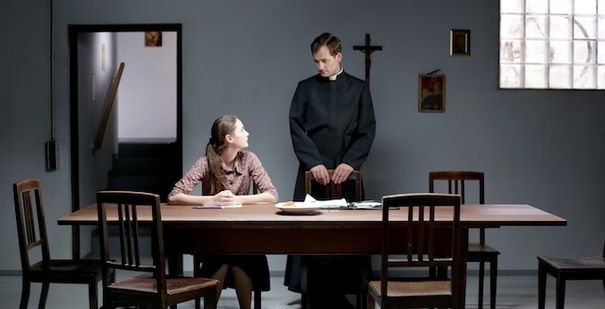Faith/Off
Andrei Kartashov of the 2014 Talent Press reviews Dietrich Brüggemann's drama of faith, youth and family STATIONS OF THE CROSS, which features in the Berlinale Competition.

Dietrich Brüggemann's STATIONS OF THE CROSS
It takes some audacity to make an adaptation of the New Testament. To parallel the story of a modern teenage girl to the life of Jesus takes even more. Dietrich Brüggemann's STATIONS OF THE CROSS (KREUZWEG, Germany) borrows its title from a traditional genre of Roman Catholic iconography that depicts Christ carrying his cross to Calvary, then his crucifixion and burial, in 14 episodes. Brüggemann's film contains the same number of scenes, and follows trials and tribulations of an extremely religious and boldly named Maria who belongs to a traditional Catholic society, abused at home for not being chaste enough and bullied at school for being too chaste. In the first scene she gives a vow to sacrifice her life for the sake of her sick little brother's well-being. She will succeed (this is hardly a spoiler since we all know the ending of the Gospels).
Having borrowed the structure from iconography, Brüggemann also adopts from cinematic tradition when it comes to imagery and mise-en-scène. The stillness of camera and the implacable lengthiness of shots are, with little doubt, influenced by Carl Theodor Dreyer, whose name has become synonymous with spiritual cinema. Like in Dreyer's œuvre, every sequence consists of only one shot, further developing a resemblance to painting. However, if the great Dane was building theodicy with visual rigour, Brüggemann is polemicizing.
From its first scene where a young priest delivers a monologue on satanic temptations, STATIONS OF THE CROSS looks like an angry satire of religious fundamentalism – a rather toothless one, too, since it’s easy to make fun of bigots – before making a twist in the penultimate chapter where we witness an authentic miracle. Christian zealots are the new Pharisees? Perhaps, but this effort to keep a foot in both celestial and earthly worlds, and simultaneously criticise fanaticism and glorifying God with his inscrutable ways, results in the film's failure to stand on the ground at all. When in the last shot the always still camera suddenly starts moving, and in an intricate pirouette pans to the blue sky, it is still hard to be convinced that someone is actually there.

